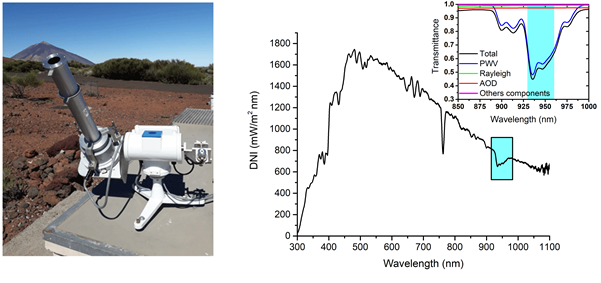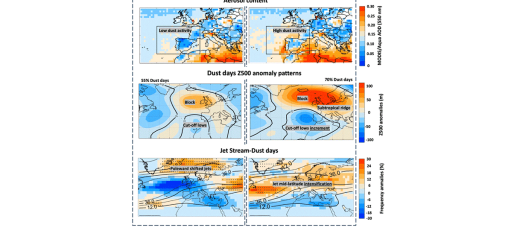Water Vapor Retrievals from Spectral Direct Irradiance Measured with an EKO MS-711 Spectroradiometer-Intercomparison with Other Techniques.
Click here for the Spanish version

Precipitable water vapor retrievals are of major importance for assessing and understanding atmospheric radiative balance and solar radiation resources. On that basis, this paper presents the first PWV values measured with a EKO MS-711 grating spectroradiometer (Figure 1) from direct normal irradiance in the spectral range between 930 and 960 nm at the Izaña Observatory (IZO, Spain) between April and December 2019.

Figure 1.- EKO MS-711 spectroradiometer installed at Izaña Observatory. Direct normal irradiance, performed with the EKO MS-711 spectroradiometer on 20 May 2019 (13:00 UTC) at IZO. The blue box indicates the water vapor absorption band selected in this work for the PWV retrievals (930–960 nm). The zoomed graphic shows the direct transmittance simulated with MODTRAN model between 850 and 1000 nm on 20 May 2019 (13:00 UTC).
The expanded uncertainty of PWV (UPWV) was theoretically evaluated using the Monte-Carlo method, obtaining an averaged value of 0.37 ± 0.11 mm. The estimated uncertainty presents a clear dependence on PWV. For PWV ≤ 5 mm (62% of the data), the mean UPWV is 0.31 ± 0.07 mm, while for PWV > 5 mm (38% of the data) is 0.47 ± 0.08 mm.
In addition, the EKO PWV retrievals were comprehensively compared against the PWV measurements from several reference techniques available at IZO, including meteorological radiosondes, Global Navigation Satellite System (GNSS), CIMEL-AERONET sun photometer and Fourier Transform Infrared spectrometry (FTIR) (Figure 2). The EKO PWV values closely align with the abovementioned different techniques, providing a mean bias and standard deviation of – 0.30 ± 0.89 mm, 0.02 ± 0.68 mm, -0.57 ± 0.68 mm, and 0.33 ± 0.59 mm, with respect to the RS92, GNSS, FTIR and CIMEL-AERONET, respectively. According to the theoretical analysis, MB decreases when comparing values for PWV > 5 mm, leading to a PWV MB between −0.45 mm (EKO vs. FTIR), and 0.11 mm (EKO vs. CIMEL-AERONET).

Figure 2.– Scatterplot of EKO PWV (mm) versus (a) RS92 PWV, (b) GNSS PWV, (c) FTIR PWV, and (d) CIMEL-AERONET PWV between April and December 2019 at IZO. The dotted lines are the least-squares fits and the black solid lines are the diagonals (x = y). The least-squares fit parameters are shown in the legend (slope, intercept and Pearson correlation coefficient R). N is the amount of data. The small figures represent the occurrence distributions of the mean bias in mm.
These results confirm that the EKO MS-711 spectroradiometer is precise enough to provide reliable PWV data on a routine basis and, as a result, can complement existing ground-based PWV observations. The implementation of PWV measurements in a spectroradiometer increases the capabilities of these types of instruments to simultaneously obtain key parameters used in certain applications such as monitoring solar power plants performance.
For more details about this work please refer to: García, R.D.; Cuevas, E.; Cachorro, V.E.; García, O.E.; Barreto, Á.; Almansa, A.F.; Romero-Campos, P.M.; Ramos, R.; Pó, M.; Hoogendijk, K.; Gross, J. Water Vapor Retrievals from Spectral Direct Irradiance Measured with an EKO MS-711 Spectroradiometer—Intercomparison with Other Techniques. Remote Sens. 2021, 13, 350. https://doi.org/10.3390/rs13030350.



